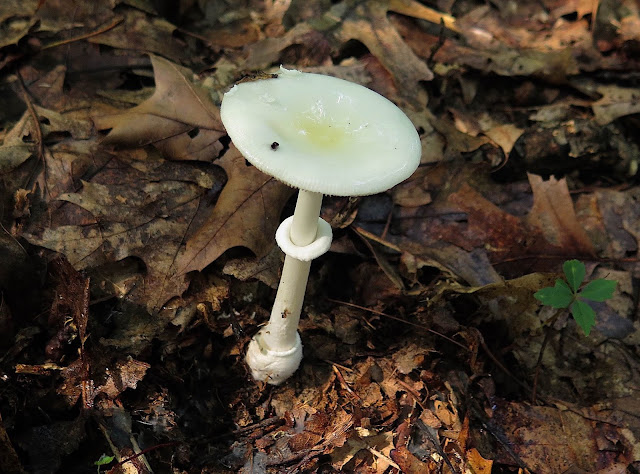I returned to Canal Park (see last post) on Saturday to re-examine a flower I have some question about, and while I was there, I saw some interesting fauna too.
The first was a wee little crab spider trying to hide from view beneath an Oxeye bloom:
The second was an incredibly iridescent tiny green bee exploring the few still-open florets of a Narrow-leaved Mountain Mint. That little bee just glittered in the sunlight.
There were also Goldenrod Soldier Beetles dining on Mountain Mint nectar.
But the most surprising visitor to the Mountain Mint was this Ailanthus Web-worm Moth, a creature usually found in more southern states. What gorgeous orange wings, decorated with black-and-white circular designs!
But not all the animal evidence I found was quite so vivacious. Some, in fact, was quite dead, like the remnants of this enormous fish I found lying on the shore. Since the skeleton was at least three-feet long, without the head, this must have been one big fish!
Sadly, here was one more dead creature, a beautiful Monarch Butterfly I found lying on the stony shore.
Most of the fungi we found on Thursday was already dying as well, but this mushroom corpse had become the home of some tiny new fungi that sprouted directly from the shriveled and slimy remains.
Here was a newly sprouted mushroom, but one we associate with death, since this is one of those fungi that can kill you if you consume it. Because it is snowy white, with a visible basal cup and stem ring, I believe this is Amanita verna, with the common name of Destroying Angel.
On a happier note, the plant I had come to re-visit -- a sprawling bush clover I still don't know the name of for certain -- had opened some of its pretty purple flowers. I'm hoping the flower's color and the number of flowers per stalk will help us determine its exact ID at last. It might be the rare Lespedeza repens or else the more common Lespedeza procumbens.
UPDATE: I have heard from a very knowledgeable responder that this plant is indeed Lespedeza repens (Creeping Bush Clover), a plant that is classified as Rare in New York, although it has been reported from Rensselaer County, the county where this specimen was growing. The determining factors were the oval leaves, the way the stem hairs lie flat to the stem, and the 2 to 6 flowers per inflorescence.









1 comment:
Very nice photos of the little critters.
Post a Comment